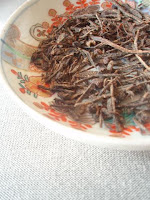It’s a pity that the Japanese young of these days became unlikely to enjoy alcohol. Aah, don’t get me wrong. Alcohol can cause hepatic and brain-related damages, or in worst cases, ruin our life at all, I know. It is, however, true as well that the moderate intake has been playing a part in keeping our body healthy.
Japanese loves to not only drink but also make “fruit liqueurs” (kajitsu-shu, 果実酒) at home, do you know? Although it’s a cinch to buy the ready-made version in cans and bottles, many households have still been taking over this tradition from our ancestors for centuries. Homemade liqueurs are very rich in minerals as well as acids, and under Japan’s Liquor Tax Act, we’re allowed to use every kind of fruits BUT grapes (and grains) at home, for domestic use only.
A wide range of seasonal fruits (and vegetables occasionally) are picked up to steep in alcohol, best of all, Japanese plum-like fruit called “ume” (梅) is the quintessential ingredient used for homemade liqueurs.
Ume fruit liqueur, aka “ume-shu” (梅酒) in Japanese, simply tastes delicious! The sweetness of the sugar perks up the sharp acidity of the ume, conjuring up that of green apples. Enjoy this syrupy liquid with ice in a smaller glass as an aperitif, or make fizz topped with soda water in a tall glass for alfresco. Being rather girly, both are great sipping drinks in summer, I promise.
The season of ume lasting from late May to June conflicts with the rainy season in Japan. This is why our rainy season is known as 梅雨 (tsuyu), these Chinese characters signifying “ume” and “rain” respectively. Around this time of year, all we need to make ume-shu are assembled in one corner or just around the entrance of every grocery and supermarket to appeal around.
So, just prepare the following items at hand:
- Fresh Ume Fruits
While there’re various ume fruits suitable for ume-shu, “nanko-bai” (南高梅) from Wakayama pref, West Japan is among the finest. Ume used for the liqueur has to be “unripened” (ao-ume, 青梅). Covered with the green thick skin, or with scarlet to amber patchly, it almost looks like a baby Granny Smith apple. - Rock Sugar
Japanese calls this “kori-zato” (氷砂糖) to mean “ice sugar” in the literature. It seems the most highly-refined form of sugar which consumers can get hold of. Lumpy in shape, translucent in colour, and fun to chew on! - White Liquor (ホワイトリカー)
This is a sort of “shochu” (焼酎), Japanese vodka especially for making fruit liqueurs. Available in paper cartons, with an alcohol content of 35% which is required to bring about the healthy maturation. - Glass Jar
Imagine a huge jam bottle with the capacity of several litters. It’s always surmounted by a plastic cap coloured with Christmassy “red” though the reason is unknown.
Nothing complicated in the method either. First of all, wash the ume fruit and remove the black stem with a skewer. Sterilise the glass jar and leave to cool whilst all the ume are dried out naturally. In the jar, then, place alternate layers of the ume and rock sugar and gently pour the liquor over them. At last, seal the jar and store in a cool and dark place. It’s ready to drink in three months, but the more the liqueur gets aged, the better the flavour will be as more than two years is my taste. You can also eat the tipsy flesh of ume on its own, make jam, or simply throw them away.
This year, my family tried a new take because my mum got a more palatable recipe from a Japanese fine dining restaurant chef on TV. The rough measurement of his concoction is something like 2kg of ume, 1kg of fruit sugar in place of rock sugar, 1.8L of white liquor plus 1.8L of “daiginjo” (大吟醸), that is highly-refined sake. Well, our choice for this is “Mansaku-no-Hana” (まんさくの花) on limited sale, brewed in Akita pref. of North Japan.
The freshly-made ume-shu is now settled in its bed room to ensure a long, deep sleep. I just remembered one Japanese proverb: “good sleep grows kids a lot”..... and ume-shu too!!

































